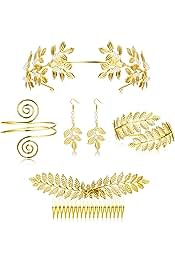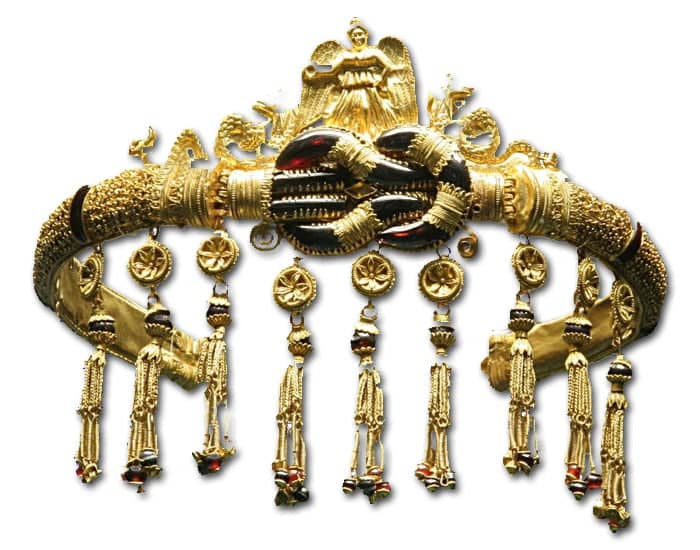Jewelry is a part of many cultures, and the Ancient Greeks were no exception. Have you ever wondered why jewelry was so important to the Ancient Greeks? What significance did it hold? In this article, we’ll explore the significance of jewelry in Ancient Greek culture, and why it was so important for them.
1. Types of Jewelry Used in Ancient Greek Culture
Jewelry was an important part of Ancient Greek culture and was used for both practical and symbolic purposes. The most common types of jewelry used in Ancient Greek culture include rings, earrings, necklaces, and pendants.
Rings were often made of gold or silver and were worn on the index finger or the middle finger. Rings often featured embossed designs of animals, plants, or gods, and were used to signify different social statuses.
Earrings were often made of gold or silver and featured designs of animals or gods. They were mainly worn by women and were used to signify social status and wealth.
Necklaces were usually made of gold or silver and featured designs of animals, plants, or gods. Necklaces were used to signify status and wealth, and were often worn by women.
Pendants were often made of gold or silver and featured designs of animals or gods. Pendants were used to signify status and wealth, and were often worn by women.
It is also worth noting that jewelry was often made of precious stones such as pearls, rubies, and sapphires, which were believed to have magical properties.
In conclusion, jewelry was an important part of Ancient Greek culture and was used for both practical and symbolic purposes. Rings, earrings, necklaces, and pendants were the most common types of jewelry used in Ancient Greek culture and were used to signify social
2. Cultural Significance of Jewelry in Ancient Greece
Jewelry has always been an important part of human culture, and this was no different in ancient Greece. Jewelry was used as a symbol of wealth and status, and it was also an important part of religious and cultural rituals.
Ancient Greek jewelry was made from a variety of materials, including gold, silver, and precious stones. Some of the most popular designs included images of animals, gods, and goddesses. Jewelry was often worn as a form of protection, and it was believed to have magical powers.
Jewelry was also an important part of ancient Greek weddings. The bride would wear a crown of flowers and a necklace made from olive leaves. The groom would often give the bride a piece of jewelry as a wedding gift.
In addition to its cultural significance, ancient Greek jewelry also had practical uses. For example, pins and brooches were used to fasten clothing, and earrings were used to keep the hair out of the face. Jewelry was also used as a form of currency, and it was often traded for goods and services.
Overall, the cultural significance of jewelry in ancient Greece cannot be overstated. It was an important part of daily life, and it played a crucial role in religious and cultural rituals.

3. Popular Jewelry Symbols and Their Meanings
Jewelry has been an important part of ancient Greek culture, and many symbols were used to convey different meanings. Here are some popular jewelry symbols and their meanings:
1. The Greek Key: Also known as the meander, this symbol represents infinity and the eternal flow of things.
2. The Evil Eye: This symbol is believed to protect against bad luck and negative energy.
3. The Owl: This bird was associated with Athena, the goddess of wisdom, and symbolizes knowledge, intelligence, and intuition.
4. The Dolphin: A symbol of friendship, joy, and playfulness, the dolphin was also associated with the god Apollo.
5. The Anchor: A symbol of stability and security, the anchor was often used in jewelry for sailors and those who worked at sea.
These symbols were often used in combination with other images, such as animals, gods, and goddesses, to create unique pieces of jewelry that conveyed a specific message or intention.
To learn more about the significance of jewelry in ancient Greek culture, check out this article from the British Museum. You can also explore the museum’s collection of ancient Greek jewelry online.

The intricate design and use of symbols reflect the importance of jewelry in ancient Greek culture.
Jewelry was an important part of Ancient Greek society, and played an integral role in the social hierarchy. Jewelry was a symbol of wealth and status, and was often used to distinguish different social classes. The wealthy upper classes wore elaborate and expensive jewelry made of gold and precious stones, while the lower classes wore jewelry made of more common materials such as bronze or iron.
Jewelry was often used to indicate marital status. Married women wore a band of gold around their necks, while unmarried women wore a band of bronze. Married men wore a seal ring on their finger, while unmarried men wore a plain band of iron. Jewelry was also used to indicate social rank, with the wealthier classes wearing more elaborate and expensive jewelry.
In addition to being a symbol of social status, jewelry was also used as a form of religious expression. Ancient Greeks believed that wearing jewelry with a religious symbol was a sign of piety and devotion to the gods. Religious jewelry was often made of gold or silver, and featured symbols such as the Cross, the Greek Key, or the Eye of Horus.
Jewelry was also used to indicate military rank. Soldiers wore jewelry made of bronze or iron to signify their rank and position. Jewelry was also used to commemorate important military victories, with soldiers wearing jewelry inscribed with the names of their victories.
Jewelry was an important part of Ancient Greek culture, and played an important role in the social hierarchy. It was a symbol of wealth and status, and was used to indicate marital status, social
5. Jewelry as a Status Symbol in Ancient Greek Society
In ancient Greek society, jewelry was an essential status symbol. Wealthy Greeks would adorn themselves with precious metals and gemstones to showcase their social standing. Jewelry was also used as a form of currency, with pieces being given as gifts or used to pay for goods and services.
The Greeks believed that jewelry had magical powers and could protect the wearer from harm. They would often bury their dead with their jewelry, believing that it would protect them in the afterlife.
Gold was the most valued metal in ancient Greece and was reserved for the wealthiest members of society. Silver was more widely used, and bronze was used for cheaper, mass-produced pieces.
Jewelry was also an important part of religious ceremonies in ancient Greece. Priests and priestesses would wear jewelry to symbolize their devotion to the gods.
Today, ancient Greek jewelry is highly valued by collectors and historians. Many museums have collections of ancient Greek jewelry on display, including the British Museum and the Metropolitan Museum of Art.

6. Influence of Jewelry on Ancient Greek Art and Literature
Jewelry played a significant role in Ancient Greek culture, influencing not just fashion but also art and literature. Greek jewelry was crafted using a variety of materials, including gold, silver, and precious stones. The intricate designs and intricate details of Greek jewelry were often inspired by nature, with motifs such as flowers, animals, and mythical creatures.
In Ancient Greek art, jewelry was often depicted on sculptures and paintings of gods and goddesses. The jewelry worn by these divine figures was seen as a symbol of their power and status. Jewelry was also a popular subject in Greek literature, with many stories featuring characters adorned with beautiful and valuable pieces.
Jewelry was not just a symbol of wealth and status, but also had practical uses in Ancient Greece. For example, amulets were worn for protection, and hairpins were used to secure hairstyles.
The influence of jewelry on Ancient Greek culture can still be seen today, with many modern jewelry designers drawing inspiration from the intricate designs and motifs of Ancient Greek jewelry.

Conclusion
Jewelry in Ancient Greek culture held profound significance, serving as more than just ornamental adornments. These pieces were deeply intertwined with the societal fabric, reflecting wealth, status, religious beliefs, and personal identity. From rings, earrings, and necklaces, to pendants, each jewelry type carried its own symbolism and was crafted meticulously using materials like gold, silver, and precious stones. These materials were not only chosen for their aesthetic appeal but also for their believed magical properties. Jewelry was a testament to one’s social standing, with the elite adorning themselves in elaborate designs, while the common folk wore simpler pieces. Additionally, jewelry played a pivotal role in religious rituals, with priests and priestesses wearing specific pieces to symbolize their devotion. The artistry of Ancient Greek jewelry also influenced other domains, such as art and literature, with depictions of divine figures adorned in exquisite pieces and literary characters described with their ornate adornments. In essence, jewelry in Ancient Greek culture was a multifaceted symbol, representing societal hierarchies, religious devotion, and personal identity, leaving an indelible mark on the annals of history and continuing to inspire modern jewelry designs.
